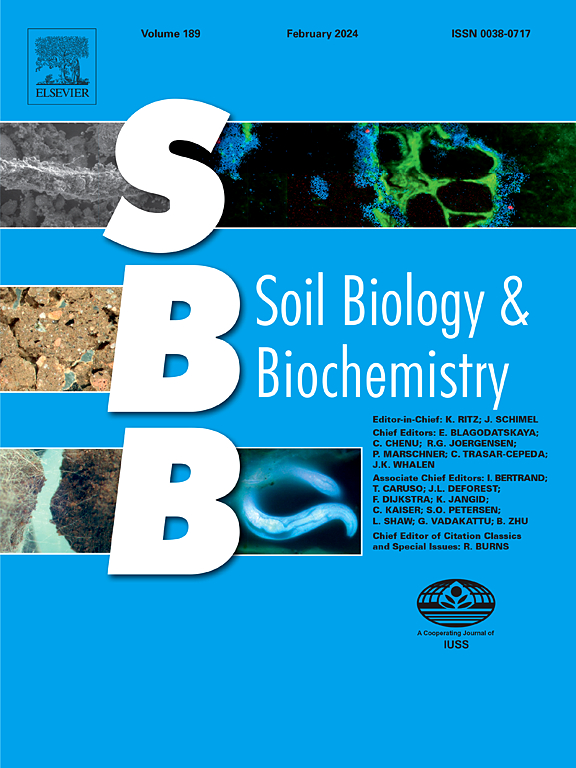Ecoregional patterns of protist communities in mineral and organic soils: assembly processes, functional traits and diversity of testate amoebae in Northern Eurasia
IF 9.8
1区 农林科学
Q1 SOIL SCIENCE
引用次数: 0
Abstract
Soil microbial communities play a crucial role in the functioning of terrestrial ecosystems. Rapid changes in climate and land-use will likely cause major changes in belowground biodiversity with unknown consequences on ecosystem functioning. The functional traits, taxonomic and functional diversities of soil microorganisms are known to vary in relation to soil type and climate, but few studies have compared these patterns and explored assembly community mechanisms systematically in contrasted ecological conditions. Here we address this gap and focus on testate amoebae, a key group of shell-producing microbial predators known to play significant roles in C and N cycling in terrestrial ecosystem. We used morphological approach to assess and compare their taxonomic and functional diversity in organic (Histosols) and mineral soils in six regions (320 samples) spanning a wide range of latitudes (52–67°N, ∼2126 km) and longitudes (46–107°E, ∼3927 km) in Central-North Eurasia. Our study revealed significant differences in testate amoeba community composition, diversity, functional traits and assembly mechanisms among ecoregions and soil type. In the ecoregions with drier soils, testate amoeba taxonomic and functional diversities were higher in organic soils compared to mineral soils, while the opposite was observed in ecoregions with wetter soils. With respect to morphological traits, in drier-soil ecoregions such as forest-steppes, testate amoebae were longer and had a relatively smaller aperture in organic soils, while the opposite is true in wetter-soil ecoregions such as taiga and tundra. Habitat filtering was identified as the leading assembly process in mineral soils, while biotic factors were more influential in organic soils. This study provides a comprehensive comparative analysis of testate amoeba communities, enhancing our understanding of how abiotic and biotic factors shape microbial communities in ecosystems, highlighting the role of soil moisture regime, and offering valuable insights for predicting ecological responses to environmental changes.
矿物和有机土壤中原生群落的生态区域格局:欧亚大陆北部土地变形虫的组合过程、功能特征和多样性
土壤微生物群落在陆地生态系统的功能中起着至关重要的作用。气候和土地利用的快速变化可能会导致地下生物多样性的重大变化,对生态系统功能造成未知的后果。土壤微生物的功能性状、分类和功能多样性随土壤类型和气候的变化而变化,但很少有研究对这些模式进行比较,并系统地探讨不同生态条件下的群落机制。在这里,我们解决了这一差距,并将重点放在了无壳变形虫上,这是一组重要的产壳微生物捕食者,已知在陆地生态系统的C和N循环中发挥重要作用。我们使用形态学方法评估和比较了它们在欧亚大陆中北部6个地区(320个样本)有机土壤和矿物土壤中的分类和功能多样性,这些地区跨越了广泛的纬度(52-67°N, ~ 2126 km)和经度(46-107°E, ~ 3927 km)。研究结果表明,不同生态区域、不同土壤类型间,土壤阿米巴原虫群落组成、多样性、功能性状和组装机制存在显著差异。在土壤较干燥的生态区,有机土壤的变形虫分类和功能多样性高于矿质土壤,而湿润土壤的变形虫分类和功能多样性则相反。在形态特征上,在森林草原等干旱土壤生态区,有机土壤中无性系变形虫更长,孔径相对较小,而在针叶林和冻土带等湿润土壤生态区,无性系变形虫的孔径相对较小。生境过滤在矿质土壤中起主导作用,而生物因子对有机土壤的影响更大。本研究对荒漠阿米巴原虫群落进行了全面的比较分析,加深了我们对非生物和生物因素如何影响生态系统中微生物群落的理解,突出了土壤湿度制度的作用,并为预测生态对环境变化的响应提供了有价值的见解。
本文章由计算机程序翻译,如有差异,请以英文原文为准。
求助全文
约1分钟内获得全文
求助全文
来源期刊

Soil Biology & Biochemistry
农林科学-土壤科学
CiteScore
16.90
自引率
9.30%
发文量
312
审稿时长
49 days
期刊介绍:
Soil Biology & Biochemistry publishes original research articles of international significance focusing on biological processes in soil and their applications to soil and environmental quality. Major topics include the ecology and biochemical processes of soil organisms, their effects on the environment, and interactions with plants. The journal also welcomes state-of-the-art reviews and discussions on contemporary research in soil biology and biochemistry.
 求助内容:
求助内容: 应助结果提醒方式:
应助结果提醒方式:


